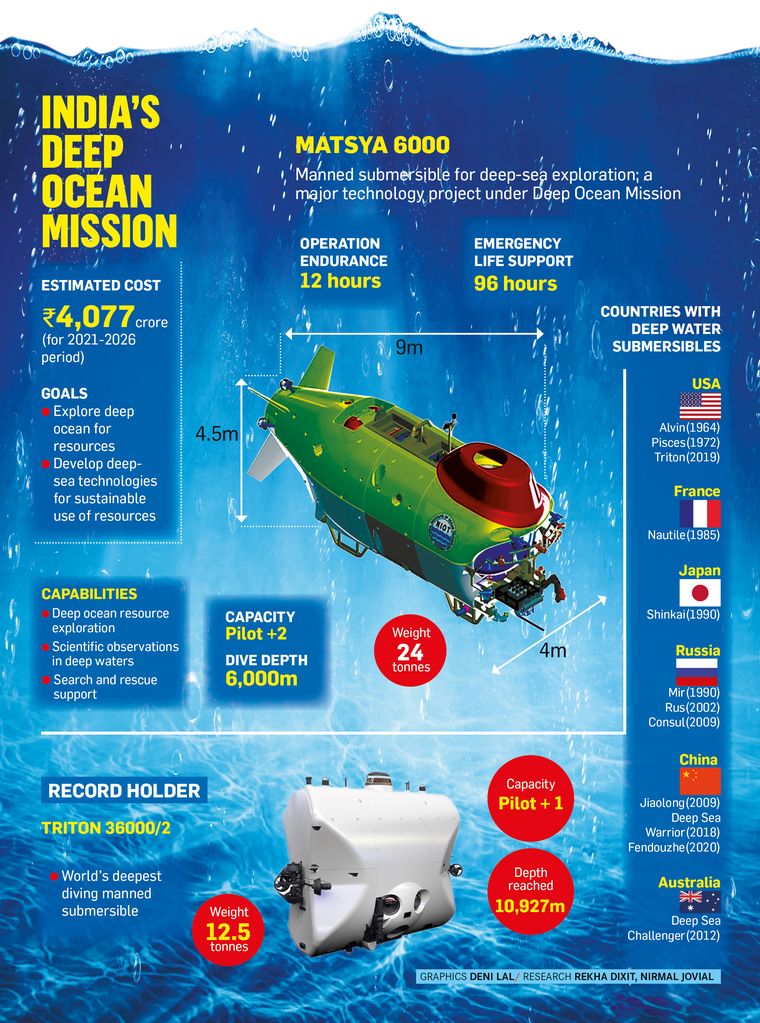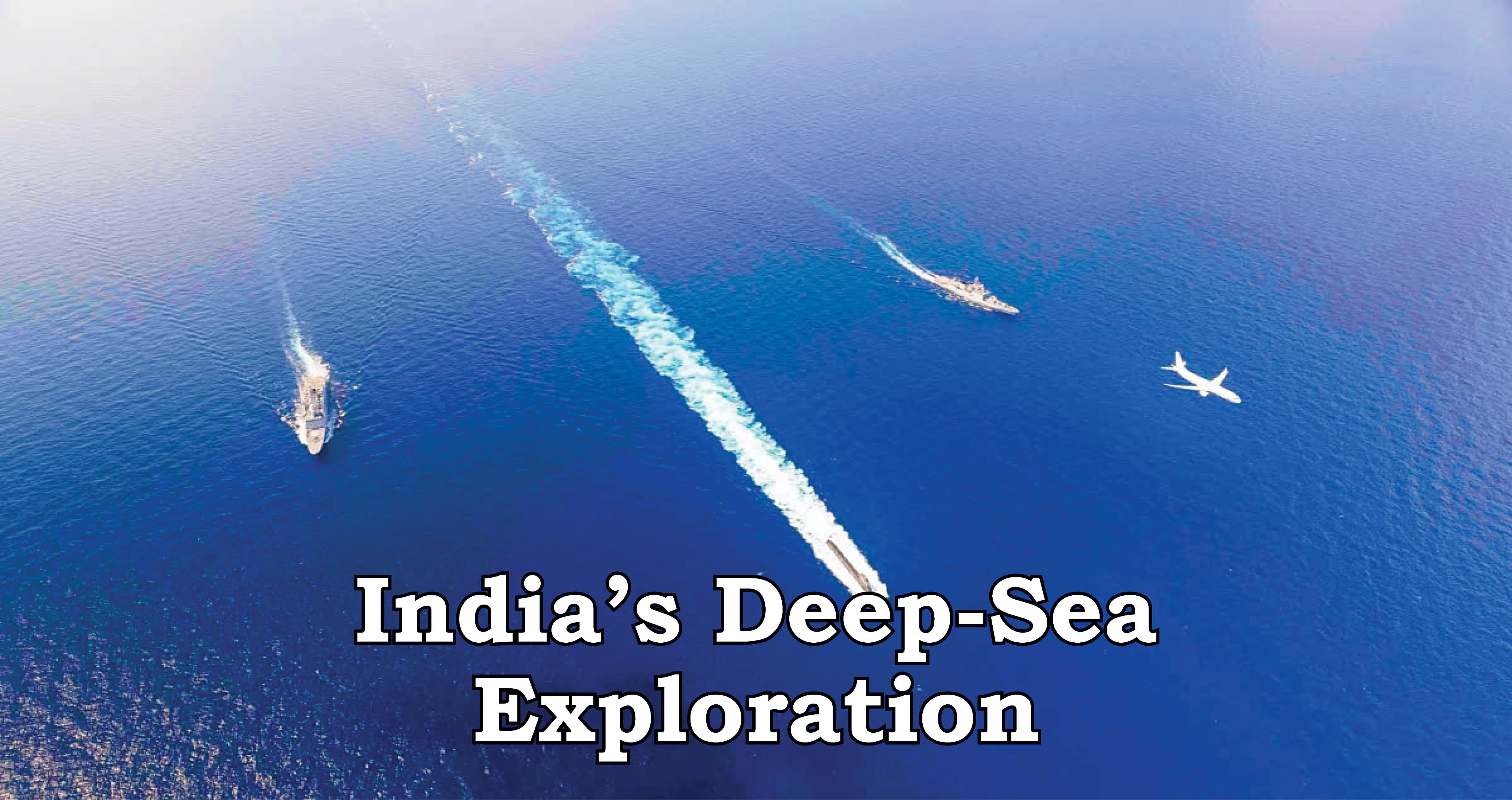Introduction
India has recently made significant strides in deep-sea exploration with the successful wet testing of the Matsya-6000 submersible, a cutting-edge vehicle capable of diving up to 6,000 meters below the ocean surface. This landmark achievement is a crucial step toward launching India’s first deep-sea manned mission, which will place the country among an elite group of nations with the capability to explore extreme ocean depths.
- However, deep-sea technology is not just about scientific exploration—it is deeply intertwined with economic aspirations, security considerations, and geopolitical challenges. Countries like China, France, Japan, Norway, Russia, South Korea, and the United States have already established a strong foothold in deep-sea technology, leveraging it for both economic gain and national security.
- China, for example, has recently unveiled a compact deep-sea cable-cutting device that can be mounted on submersibles and used to sever heavily fortified undersea communication and power lines. This development signals the increasing militarization of the deep ocean, making it critical for India to accelerate its deep-sea capabilities to ensure security, economic progress, and scientific advancement.
The Strategic and Economic Importance of Deep-Sea Exploration
- The ocean is a vast and largely unexplored domain, holding immense economic, scientific, and strategic value. The United Nations Convention on the Law of the Seas (UNCLOS) grants nations an Exclusive Economic Zone (EEZ) extending 200 nautical miles (370 km) from their coastlines, where they have exclusive rights to explore and exploit marine resources.
- India’s EEZ covers an average depth of 3,741 meters—a depth more than four and a half times the height of the Burj Khalifa, the world’s tallest building. While this may seem extreme, it is relatively shallow compared to the Challenger Deep in the Mariana Trench, which plunges more than 10 kilometers beneath the ocean surface, exceeding the cruising altitude of most aircraft.

India’s deep-sea exploration is essential for:
1. Resource Extraction:
o Living resources: Marine biodiversity, fish stocks, and aquaculture.
o Non-living resources: Gas hydrates, polymetallic nodules, rare earth minerals, oil, and natural gas.
o Nutraceuticals: Bioactive compounds extracted from deep-sea organisms with potential applications in medicine, pharmaceuticals, and nutrition.
2. Scientific and Meteorological Research:
o Climate change monitoring: Studying deep-sea currents, carbon sequestration, and ocean temperatures can help predict climate patterns and mitigate environmental risks.
o Ocean mapping: Understanding the geology of the seabed can assist in earthquake prediction, tsunami modeling, and disaster mitigation.
3. Underwater Infrastructure and Connectivity:
o Undersea cables: More than 95% of global intercontinental internet traffic relies on undersea fiber-optic cables, which support banking transactions, defense communications, and global trade.
o Oil pipelines: Subsea pipelines transport energy resources, making them critical for the global economy.
4. Maritime Security and Strategic Interests:
o Undersea surveillance: Developing advanced deep-sea monitoring technologies is essential to detect foreign military activities in India’s territorial waters.
o Cable security: As seen with China’s cable-cutting device, adversarial nations could target undersea infrastructure to disrupt communications and financial networks, making deep-sea security a national priority.

Challenges in Deep-Sea Exploration
Despite its vast potential, deep-sea exploration is extremely challenging due to harsh environmental conditions and high costs of technology development.
1. Pressure and Structural Integrity
- Pressure increases by one atmosphere (atm) for every 10 meters of ocean depth.
- At the ocean bed in India’s EEZ, pressure exceeds 380 atm—or 380 times the atmospheric pressure at sea level.
- Deep-sea vehicles must be constructed using specialized materials, such as titanium alloys and composite structures, to withstand this extreme pressure.
- The OceanGate Titan submersible disaster in June 2023 serves as a reminder of the risks involved when deep-sea vessels are not designed with the highest safety standards.
2. Communication Limitations
- Unlike air and space, where radio waves travel freely, water severely restricts electromagnetic waves.
- Acoustic signals (sound waves) are the primary mode of deep-sea communication, but their transmission is affected by temperature, salinity, and pressure.
- Very Low Frequency (VLF) and Extremely Low Frequency (ELF) sound technologies represent the frontier of deep-sea communication, requiring substantial investment and research.
3. High Costs and Technological Barriers
- Developing deep-sea research vessels, robotic submarines, and communication systems demands a multi-billion-dollar investment.
- Advanced nations like China, the US, and Russia have been investing heavily in deep-sea technologies for decades, while India is still in the early stages of development.
India’s Current Efforts and Gaps in Deep-Sea Development
Recognizing the strategic importance of the deep sea, India launched the Deep Ocean Mission (DOM) in 2018, under the Ministry of Earth Sciences. The Matsya-6000 submersible is a part of this initiative, and it represents a crucial step in developing India’s capability to explore the deep ocean for economic, scientific, and strategic purposes.
However, significant gaps remain:
- India lacks advanced deep-sea fishing capabilities, which limits its ability to fully utilize marine resources.
- Unlike leading maritime nations, India has not developed robust security mechanisms to protect undersea infrastructure.
- Investments in deep-sea mining, robotics, and advanced communication systems remain insufficient.
Strategic Recommendations for India
To become a global leader in deep-sea exploration, India must adopt a multi-pronged approach that integrates technological innovation, institutional reforms, and strategic defense measures.
1. Institutional and Policy Reforms
- Upgrade the Department of Ocean Development to a full-fledged ministry, led by a cabinet-rank minister.
- Establish dedicated research institutions for deep-sea exploration, similar to China’s deep-sea research centers.
- Foster public-private partnerships to encourage domestic industries to invest in deep-sea technology.
2. Technological Advancement and Research
- Invest in advanced sonar and sensor technology for deep-sea mapping and surveillance.
- Develop autonomous underwater vehicles (AUVs) and remotely operated vehicles (ROVs) for deep-sea exploration and maintenance.
- Strengthen deep-sea mining capabilities to extract polymetallic nodules and gas hydrates.
3. Maritime Security and Infrastructure Protection
- Implement surveillance networks to detect potential threats to India’s underwater assets.
- Develop countermeasures against hostile underwater activities, such as China’s deep-sea cable-cutting device.
- Expand undersea infrastructure projects, including communication cables, pipelines, and research stations.
4. Mission-Oriented Approach
- Launch a 10-year strategic plan for deep-sea development, with time-bound goals and strict accountability measures.
- Ensure high-level funding for deep-sea research and technology development.
Conclusion
India’s deep-sea initiatives, led by the Deep Ocean Mission, mark an essential step toward becoming a major maritime power. However, significant advancements in deep-sea research, security, and technology are needed to compete with established global players. Given the increasing importance of underwater resources, digital connectivity, and maritime security, India must treat deep-sea development as a national priority, ensuring that it is well-equipped to harness the vast potential of the deep ocean for economic growth and strategic security.
| Main question: The deep sea holds vast resources, including minerals, gas hydrates, and biodiversity. Evaluate the challenges associated with harnessing these resources and propose strategies for sustainable and environmentally responsible exploitation. |








